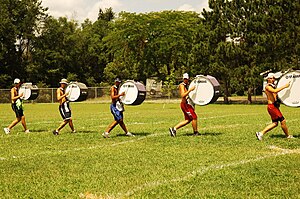Difference between revisions of "AY Honors/Drumming & Percussion/Answer Key"
(No difference)
|
Revision as of 02:03, 27 April 2007

A drumline or drum line is a group of percussion instruments usually played as part of a marching ensemble. Drumlines are usually incorporated into high school or college marching bands, drum and bugle corps or drum and lyre corps, indoor percussion ensembles, and pipe bands, but also can exist independent of these ensembles.
The term battery is often interchangeable with drumline, but refers specifically to mobile percussion – especially snare, tenor, and bass drums, and cymbals. Stationary percussion within a marching ensemble is called the front ensemble or pit.
Composition
Drumlines typically consist of marching snare drums, tenor drums, bass drums, and – less universally – cymbals. In the past, marching timpani were common before the adoption of the front ensemble, as were marching keyboard percussion instruments such as glockenspiels and xylophones. Marching steelpans are rarely part of drumlines due to issues with volume and durability, and are typically used in large ensembles with only steelpans.
Snares
Marching snare drums have high tension heads typically made of Kevlar or PET film. In the past, snares were typically carried with slings, and because of the tilt performers used traditional grip. Most modern snare drums have rigid over-the-shoulder harnesses that hold the drum with the playing surface parallel to the ground, which affords the option of performing with matched grip.
Snare parts are typically unison and provide the center rhythm of the drumline. The snare drum line is the center of tempo in the ensemble, and the "center snare", a position typically held by the most experienced snare drummer, is responsible for maintaining the tempo. When rehearsing or performing, the center snare may "tap off" the ensemble, setting the tempo with a solo rhythm.
Tenors
Contemporary tenor drums (also called toms, quads, or quints) single-headed tonal drums mounted four to six to a set. Tenor players add pitch variety to the drumline with drums of different sizes and tuning. Tenor players use matched grip, and generally play with mallets with plastic disc-shaped heads, though traditional drumsticks and softer mallets are commonly used to achieve different timbres. Tenor drummers typically play in unison.
Basses

Marching bass drums are most frequently used as tonal drums split between several percussionists. Each drummer plays a unique part, though the entire bass drum part is conceived as a whole. Marching bass drums, which produce the deepest sound in the battery, are larger drums carried on harnesses with the heads facing the front and back sidelines. The musicians carrying the bass drums typically line up in size order. Bass drummers use sticks with rounded or cylindrical heads often made of hard felt. Small bass drum lines typically consist of four members to ensure enough for a melody, and large lines can have eight or more drummers.
Cymbals
Marching cymbals are typically pairs of clash cymbals played in a variety of ways. Cymbals are bronze with leather carrying straps. Players in cymbal lines may all carry the same size and type of cymbal, or a variety of instruments may be used. Cymbals are played being held before the body, in unison or split parts. In addition to being played by the cymbalists, snare drummers may play on the cymbals as ride cymbals or like hi-hats, thus there is typically a minimum of one cymbalist for every two snare drummers. Cymbals are also used for visual effects due to their reflective surfaces. Many contemporary field ensembles do not utilize a cymbal line, as cymbals are played in the front ensemble.
Front ensemble
The front ensemble (also called the pit) can include any percussion instrument. Typical front ensembles include mallet instruments such as marimbas, xylophones, and vibraphones, timpani, cymbals, concert bass drums, gongs, tom-tom drums, and a variety of concert and world percussion instruments. Instruments may be mechanically or electronically amplified. Some competitive circuits also allow electronic instruments such as synthesizers and bass guitars, which are typically part of the front ensemble. This wide selection of instruments allows for great timbre variety. Most front ensembles centered in front of the front sideline of an American football field.
External links
- Drumline Discussion Board
- PercussionMedia - Huge collection of drumline/percussion videos
- Shot Drum - Large collection of drumline videos
